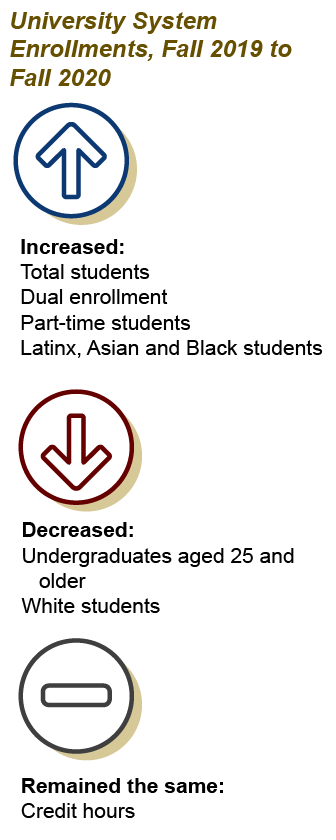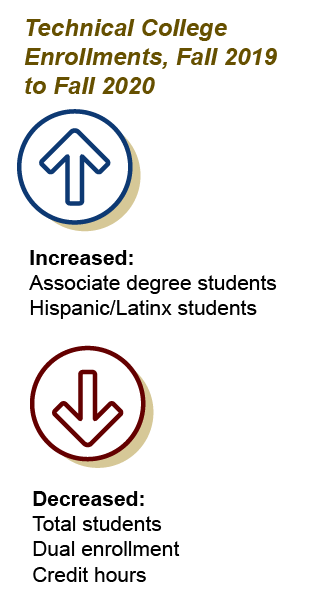As Georgia’s public colleges and universities faced the fall semester with both the coronavirus and an economic downturn, the outlook for enrollments was unclear.
Postsecondary enrollment tends to rise with the unemployment rate, but the pandemic introduced new challenges to individuals’ and families’ health, caregiving responsibilities and financial security. Though University System of Georgia (USG) schools saw increased enrollments, technical colleges experienced steep drops from the double impacts of coronavirus and new Dual Enrollment policies.
The following comparisons are between Fall 2019 and Fall 2020. Data will be available later this year for the spring semester, which will provide a more complete picture for the academic year.
University System Enrollment Grew Despite Pandemic, But Credit Hours Stayed Flat
- Though some schools experienced enrollment declines, total numbers of beginning freshmen, undergraduate and Dual Enrollment students in USG schools continued to grow in Fall 2020. First-time freshman enrollment increased 5 percent, after averaging less than 2 percent the past several years. Total undergraduate enrollment rose 1.1 percent, after being flat for several years. Dual Enrollment increased by 9 percent.
- Total graduate and professional student enrollment grew 10 percent. More graduating seniors might have decided to continue their education instead of facing a challenging job market.
- Part-time enrollment rose by two percentage points in the university system. One out of three USG students attends part-time.
- Total credit hours taken by students held basically flat. Though more students enrolled, they took fewer classes overall. Credit hours are one of the major inputs into the funding formulas that determine state funding requests.
Increases among Latinx, Asian and Black Students Continue
- Following pre-pandemic trends, undergraduate enrollment continued to grow among Latinx and Asian undergraduate students and decline for white students. After decreasing for several years, Black undergraduate student enrollment grew from Fall 2019 to Fall 2020.
- Men and women both experienced small enrollment increases, with women slightly increasing their student share to 57 percent.
- Enrollment of undergraduate students age 25 and over continued to fall, representing about 14 percent of undergraduates, or about 40,000 students. Two out of three Georgians age 25 and older do not have a bachelor’s degree. Eight percent have an associate degree, and 20 percent have some college but no degree.
University System Enrollment Changes Vary Widely by School
The University System of Georgia encompasses 22 schools, from small colleges in rural areas that focus on associate degrees to large research universities. The university system categorizes schools in four sectors that differ by research activity, degrees offered, selectivity and funding levels.
- Overall, Georgia’s research universities (University of Georgia, Georgia Institute of Technology, Georgia State University, Augusta University) saw enrollment declines among freshmen and sophomores, but not juniors and seniors. Georgia State University, Georgia’s largest public university, saw an increase in student enrollment, but a decline in credit hours. More students enrolled part-time.
- Most regional comprehensive universities (Kennesaw State University, University of West Georgia, Valdosta State University, Georgia Southern University) saw big increases in freshmen class enrollment, although the University of West Georgia did not. SAT and ACT scores were not used for admissions purposes in 2020, and one factor in the growth might be more students enrolling who might not otherwise have had the required SAT and ACT scores.
- State universities (Albany State University, Georgia College and State University, Armstrong State University, Georgia Southwestern State University, Clayton State University, Middle Georgia State University, Columbus State University, Savannah State University, Fort Valley State University, University of North Georgia) saw both increases and decreases in enrollment. Georgia College and State University, Savannah State University and the University of North Georgia experienced enrollment declines, while all other schools experienced growth.
- State colleges (Abraham Baldwin Agricultural College, Georgia Highlands College, Atlanta Metropolitan State College, Gordon State College, College of Coastal Georgia, East Georgia State College, Dalton State College, South Georgia State College, Georgia Gwinnett College) focus on associate degrees, with bachelor’s degrees in certain disciplines. They also tend to serve more part-time students and are more likely to be in rural areas. State colleges have long experienced enrollment declines and continued to see downturns, except Abraham Baldwin Agricultural College.
Technical College Enrollment Drops, Especially For Dual Enrollment Students
The Technical College System of Georgia encompasses 22 colleges throughout the state that offer short-term certificates and diplomas and two-year applied associate degrees in specific occupational fields. Technical colleges offer both academic and career, technical and agricultural education (CTAE) courses. Students range from high schoolers taking courses through Dual Enrollment to older adult students training for specific careers.
- Total enrollment in technical colleges fell by 8,800 students, or 8.5 percent. Credit hours fell by 9.8 percent.
- The biggest declines in enrollment came from students who were taking courses at technical colleges but were not enrolled in specific certificate, diploma or associate degree programs, particularly Dual-Enrolled high school students. Dual Enrollment students decreased by 5,249 students, or 19 percent.
- The largest declines in Dual Enrollment stem from 14- and 15-year-olds. These students were most likely to be affected by changes implemented in 2020 that made ninth-graders ineligible for Dual Enrollment. All 10th-graders can take career, technical or agricultural education courses, but are ineligible for core academic courses unless they make certain scores on the SAT or ACT.
- Black and white students’ participation in Dual Enrollment declined by the same large margins, Asian student enrollments declined less, and Latinx student enrollment increased.
- Technical college enrollment of male students dropped more than twice as much as female students.
- Full-time enrollment in technical colleges decreased more than part-time enrollment.
- Enrollment fell very heavily in colleges where a quarter or more of the students came through Dual Enrollment.
Enrollment Growth Among Associate Degree and Hispanic/Latinx Students
- Despite general downturns, associate degree enrollment grew in technical colleges, with a 2 percent increase overall and 19 percent increase among Dual Enrollment students.
- Enrollment by Hispanic or Latinx students grew by 3 percent overall; in Dual Enrollment, by 4.4 percent.
- Enrollment by 31- to 35-year-olds grew by 3 percent.
Potential Effects on State Budget Lag Enrollment
Student enrollment measured by credit hours drives the funding formulas that determine state funding requests from the University System and Technical College System of Georgia. Enrollment numbers lag budgets by two years; policymakers will use credit hours for the 2020-2021 school year to put together budgets for fiscal year 2023. This means that enrollment drops in technical colleges this past academic year will affect funding recommendations TCSG makes early next year.
The FY 2022 budget funded two years of enrollment-driven formula increases that preceded the pandemic for USG and TCSG but failed to fully restore the 10 percent cuts in the FY 2020 budget. The 2022 budget for the University System of Georgia beginning July 1 is still $104 million less than the pre-pandemic budget passed two years ago, and technical college funding is $26 million less than the pre-pandemic budget passed two years ago.
The FY 2022 budget also recognizes up to $260 million in one-time federal American Rescue Plan Act funds that technical colleges can draw down and up to $949 million for USG schools. Half of all funds must be regranted directly to students. The other half can be spent on expenses related to coronavirus such as additional technology and testing, and lost revenues related to coronavirus. Additional federal guidance on allowable uses, including time period of fund availability, is forthcoming. State lawmakers will meet next session to determine appropriate funding levels for colleges and universities beyond one-time federal funds.










